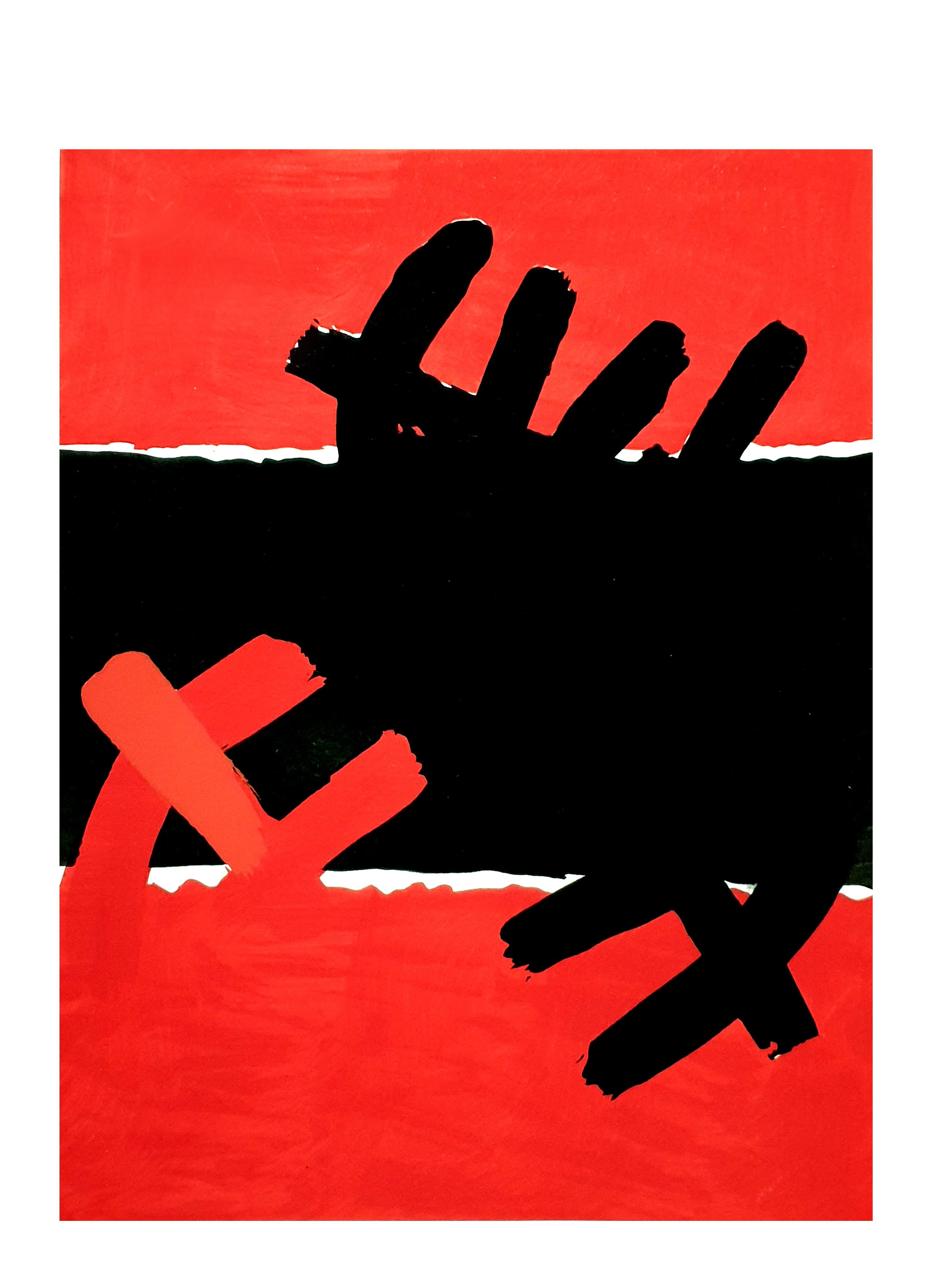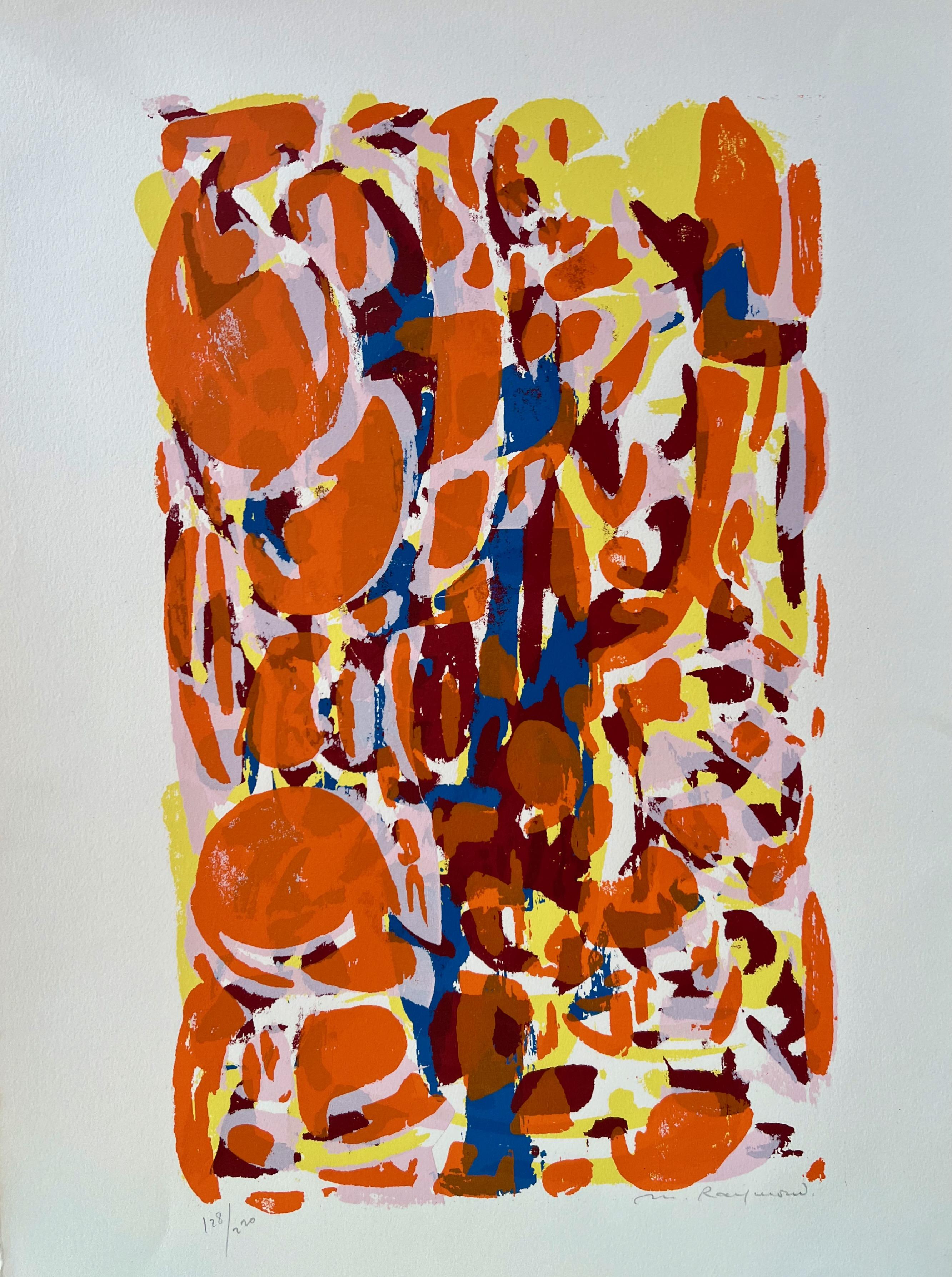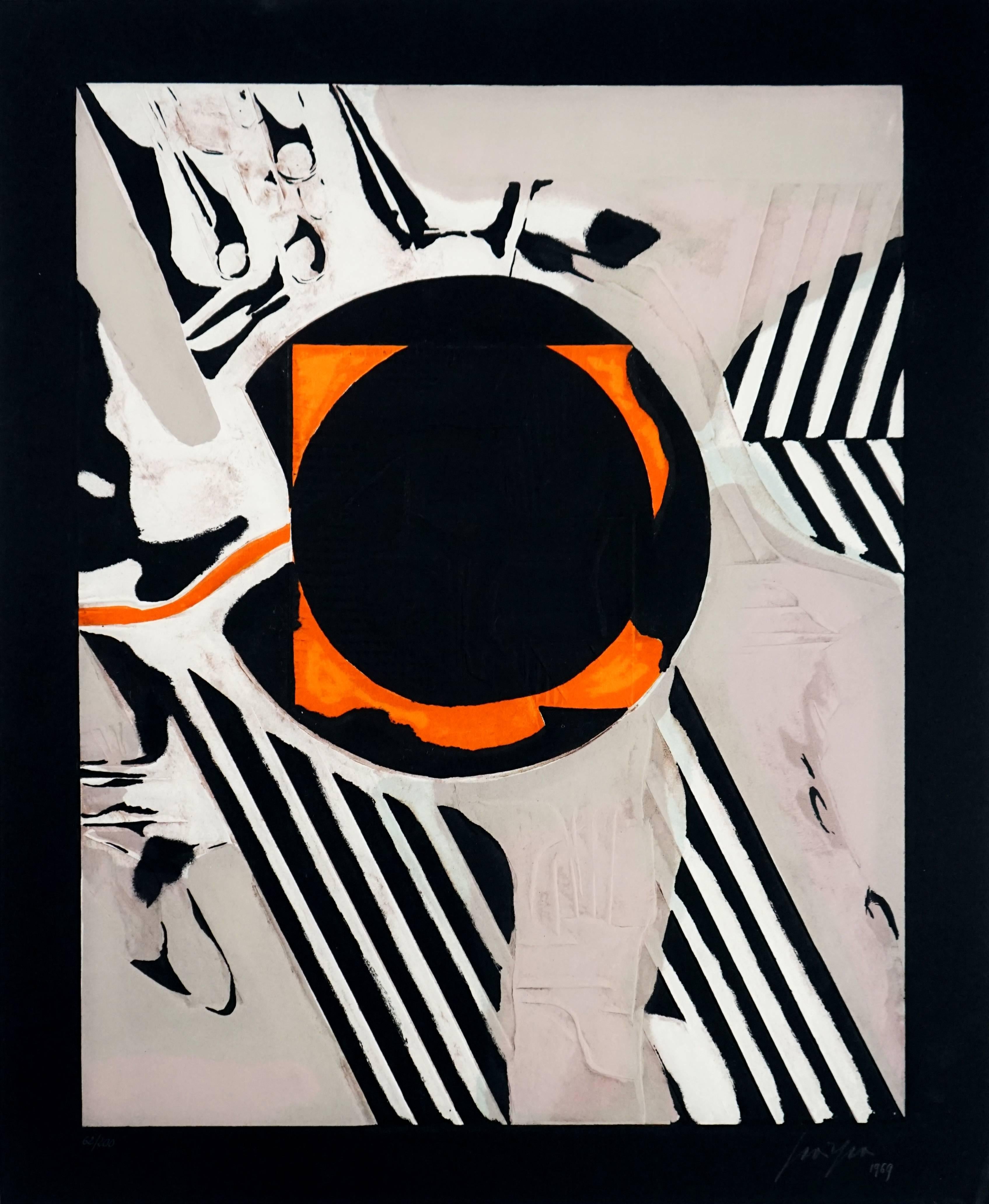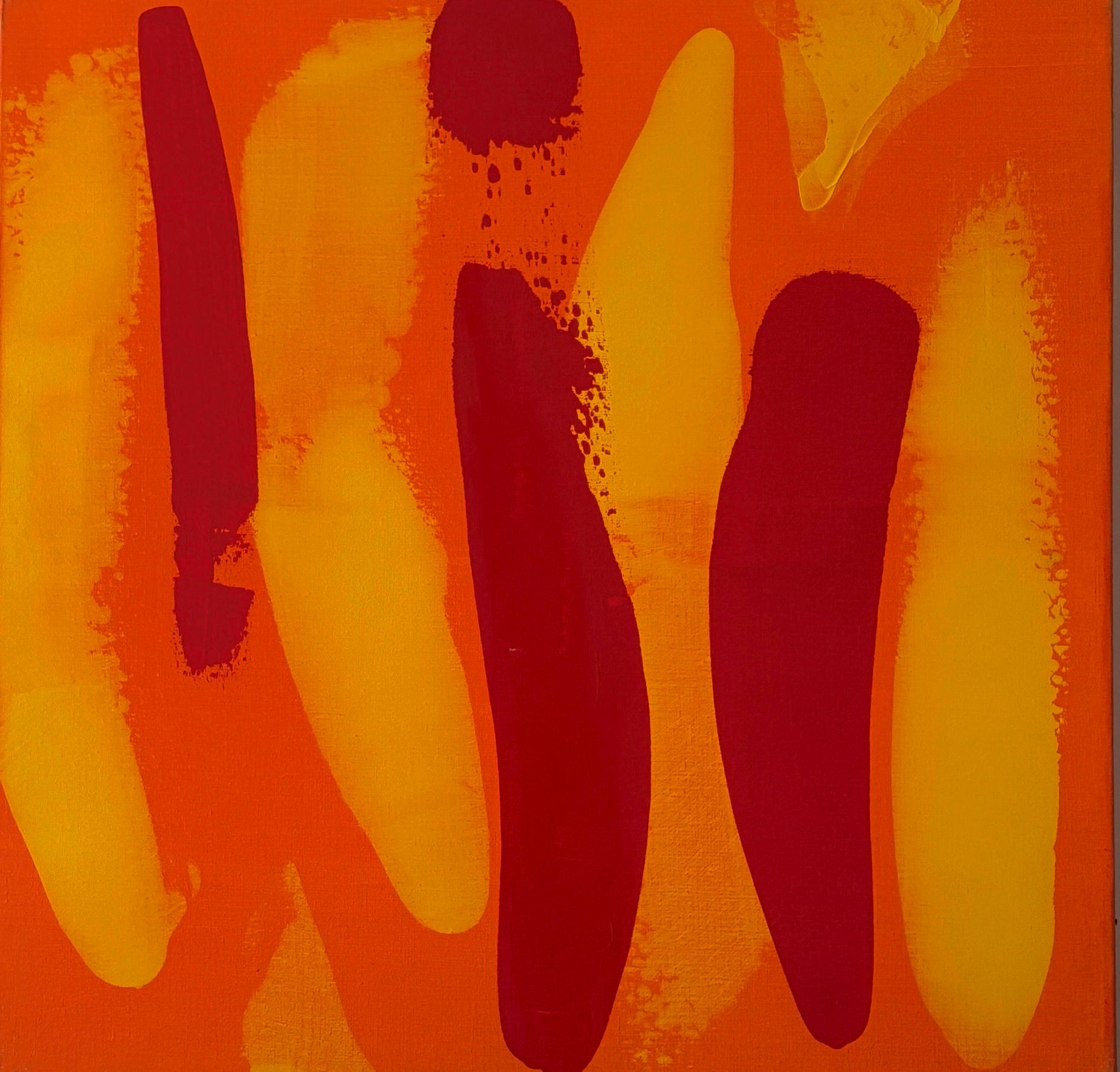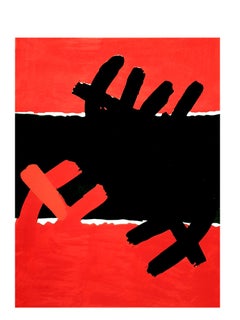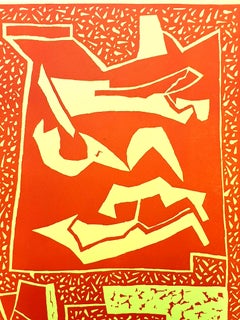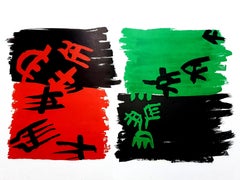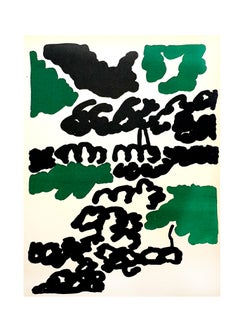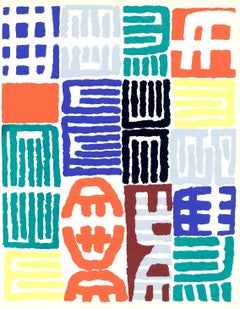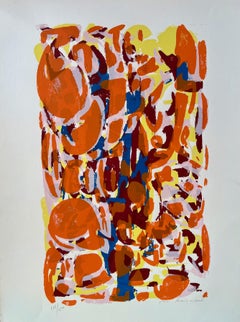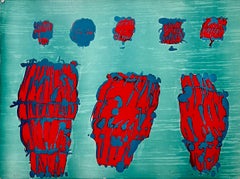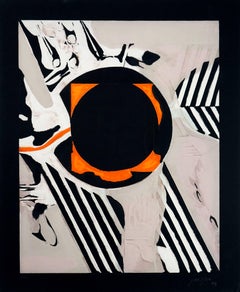Items Similar to Giuseppe Capogrossi - Stencil
Want more images or videos?
Request additional images or videos from the seller
1 of 8
Guiseppe CapogrossiGiuseppe Capogrossi - Stencil1958
1958
$836.65
£625.66
€700
CA$1,153.49
A$1,265.98
CHF 665.29
MX$15,064.88
NOK 8,504.38
SEK 7,771.32
DKK 5,334.29
About the Item
Giuseppe Capogrossi - Stencil
1958
Dimensions: 32 x 25 cm
Edition: G. di San Lazzaro.
Giuseppe Capogrossi
B. 1900, ROME; D. 1972, ROME
Giuseppe Capogrossi was born on March 7, 1900, in Rome. In 1922 he completed his law degree but soon after devoted himself entirely to painting and joined Felice Carena's atelier. Between 1927 and 1931, Capogrossi traveled frequently to Paris, and along with Corrado Cagli and Emanuele Cavalli worked in a figurative style characterized by pale and ethereal tones, which endowed their compositions with a mysterious, almost magical aura. The three artists were among the loose association of painters that came to be known as Scuola Romana (Roman School). In 1933 they collaborated on the "Manifesto del primordialismo plastico" (Manifesto of plastic primordialism), in which they discussed the presence of the archaic in the contemporary world. From the mid-1930s, Capogrossi adopted a darker palette, and between 1945 and 1948 his figurative tonal painting gave way to an increasingly abstract geometric style.
A decisive shift in Capogrossi's career took place in 1949, when he developed a vocabulary of irregular comb- or fork-shaped signs. With no allegorical, psychological, or symbolic meanings, these structural elements could be assembled and connected in countless variations. Intricate and insistent, Capogrossi's signs determined the construction of the pictorial surface. Similar to mysterious lists or sequences, his paintings were immediate in their appeal yet remained hard to decode, a quality he shared with Art Informel practitioners. These abstract comb-sign paintings, usually known simply as Surfaces (Superficies), were begun in 1949 and first exhibited at the Galleria del secolo, Rome, in 1950. Soon becoming the hallmark of Capogrossi's style, the comb sign dominated his oeuvre until the end of his career.
In 1951, Capogrossi joined Mario Ballocco, Alberto Burri, and Ettore Colla in showing work at Aurora 41, Rome, an occasion that marked the debut of the group Origine (Origin, 1950–51). Primarily concerned with the promotion of abstract art, the group reacted against mainstream realist practices and advocated a simplified language meant to return art to its origins. The following year, Capogrossi joined the Movimento spaziale (Spatial movement, 1947–60), initiated by Lucio Fontana in Milan. Readily embracing the many changes affecting the country in the postwar era, especially scientific progress, the group advocated for a new spatial art that acknowledged recent inventions such as television and neon lighting.
Capogrossi's singularity was recognized both in Italy and abroad, and he took part in group exhibitions at Galerie Nina Dausset, Paris (1951); Guggenheim Museum (1953); Venice Biennale (1954, 1962); Documenta, Kassel, West Germany (1955, 1959); Carnegie International, Pittsburgh (1958, 1961); and Tate Gallery, London (1964). Capogrossi has also been the subject of numerous solo shows at institutions including the Institute of Contemporary Arts, London (1957); Leo Castelli Gallery, New York (1958); Palais des beaux-arts, Brussels (1959); and Galleria L'attico, Rome (1962). Capogrossi died on October 9, 1972, in Rome. Two years later the Galleria nazionale d'arte moderna, Rome, organized his first major posthumous retrospective.
- Creator:Guiseppe Capogrossi (1900 - 1972, Italian)
- Creation Year:1958
- Dimensions:Height: 12.6 in (32 cm)Width: 9.85 in (25 cm)Depth: 0.04 in (1 mm)
- Medium:
- Movement & Style:
- Period:
- Condition:
- Gallery Location:Collonge Bellerive, Geneve, CH
- Reference Number:1stDibs: LU16123591962
About the Seller
4.9
Gold Seller
Premium sellers maintaining a 4.3+ rating and 24-hour response times
Established in 2015
1stDibs seller since 2015
972 sales on 1stDibs
Typical response time: 1 hour
- ShippingRetrieving quote...Shipping from: Collonge Bellerive, Geneve, Switzerland
- Return Policy
More From This Seller
View All(after) Giuseppe Capogrossi - Stencil
By Guiseppe Capogrossi
Located in Collonge Bellerive, Geneve, CH
after Giuseppe Capogrossi - Stencil
1957
Dimensions: 32 x 25 cm
Edition: G. di San Lazzaro.
From the art revue XXe siècle
Unsigned and unumbered a...
Category
1950s Abstract Expressionist Abstract Prints
Materials
Stencil
Alberto Magnelli (after) - Composition
By Alberto Magnelli
Located in Collonge Bellerive, Geneve, CH
Alberto Magnelli (after)
Untitled (Composition)
Linoleum cut (after the original) on yellow wove paper
32 x 24 cm
1959
From XXe siècle (No. 13)
Published in Paris by San Lazzaro, th...
Category
1950s Abstract Geometric Abstract Prints
Materials
Linocut
Giuseppe Capogrossi - Original Lithograph
By Guiseppe Capogrossi
Located in Collonge Bellerive, Geneve, CH
Giuseppe Capogrossi - Original Lithograph
Colorful Abstraction
1969
From the art revue XXe Siecle
Dimensions: 19 x 12.25 inches
Edition: G. di San ...
Category
1960s Modern Figurative Prints
Materials
Lithograph
Charles Lapicque - Composition - Original Lithograph
By Charles Lapicque
Located in Collonge Bellerive, Geneve, CH
Charles Lapicque - Composition - Original Lithograph
Published in the deluxe art review, XXe Siecle
1951
Dimensions: 32 x 24 cm
Publisher: G. di San Lazzaro.
Unsigned and unnumbered...
Category
1950s Abstract Expressionist Landscape Prints
Materials
Lithograph
(after) Alberto Magnelli - Composition - Pochoir
By Alberto Magnelli
Located in Collonge Bellerive, Geneve, CH
(after) Alberto Magnelli - Composition - Pochoir
Conditions: excellent
32 x 24 cm
1957
From XXe siècle, San Lazzaro
Unsigned and unumbered as issued
Category
1950s Abstract Geometric Abstract Prints
Materials
Stencil
Pierre Alechinsky - Composition - Original Lithograph
Located in Collonge Bellerive, Geneve, CH
Pierre Alechinsky - Composition - Original Lithograph
From the literary review "XXe Siècle"
1960
Dimensions: 32 x 24 cm
Publisher: G. di San Lazzaro.
Unsigned and unumbered as issued
Category
1960s Abstract Abstract Prints
Materials
Lithograph
You May Also Like
Giuseppe Capogrossi, Untitled I, from XXe Siecle 1958
By Giuseppe Capogrossi
Located in Southampton, NY
This exquisite lithograph by Giuseppe Capogrossi (1900–1972), titled Sin titulo I (Untitled I), from the album XXe Siecle, Nouvelle serie, XXe Annee, No. 10 (double), Mars 1958, orig...
Category
1950s Modern Abstract Prints
Materials
Lithograph
$956 Sale Price
20% Off
Free Shipping
abstract composition
By Marie Raymond
Located in Belgrade, MT
This color lithograph is part of my private collection since the 1970's. Marie Raymond was a pioneer post WWII painter of her generation. She was a lyrical abstractionist of her time...
Category
Mid-20th Century Abstract Expressionist Abstract Prints
Materials
Color, Lithograph
$600 Sale Price
20% Off
Pietro Consagra Italian Mod Abstract Expressionist Forma, Art Brut Lithograph
By Pietro Consagra
Located in Surfside, FL
Pietro Consagra (Italian, 1920-2005).
Hand signed in pencil and numbered limited edition color lithograph on Magnani paper.
Embossed stamp with limited edition numbers in pencil to lower left, and having artist pencil signature to lower right.
(from a limited edition of 80 with 15 artist's proofs)
Published by Stamperia 2RC, Rome Italy and Marlborough Gallery, Rome, Italy.
Abstract Modernist work in colors, produced in the style of the Forma art movement of Postwar Italy, of which the artist was a prominent member.
Pietro Consagra (1920 – 2005) was an Italian Post war artist working in painting, printmaking and sculpture. In 1947 he was among the founding members of the Forma 1 group of artists, proponents of structured abstraction. (similar to the Art Informel and Art Brut in France and the Brutalist artists)
Consagra was born on 6 October 1920 in Mazara del Vallo, in the province of Trapani in south-western Sicily, to Luigi Consagra and Maria Lentini. From 1931 he enrolled in a trade school for sailors, studying first to become a mechanic, and later to become a captain. In 1938 he moved to Palermo, where he enrolled in the liceo artistico; despite an attack of tuberculosis, he graduated in 1941, and in the same year signed up at the Accademia di Belle Arti, where he studied sculpture under Archimede Campini. After the Invasion of Sicily and the Allied occupation of Palermo in 1943, Consagra found work as a caricaturist for the American Red Cross club of the city; he also joined the Italian Communist Party. Early in 1944, armed with a letter of introduction from an American officer, he travelled to Rome. There he came into contact with the Sicilian artist Concetto Maugeri, and through him with Renato Guttuso, who was also Sicilian and who introduced him to the intellectual life of the city and to other postwar artists such as Leoncillo Leonardi, Mario Mafai and Giulio Turcato. Consagra signed up at the Accademia di Belle Arti di Roma in September 1944 and studied sculpture there under Michele Guerrisi, but left before completing his diploma.
In 1947, with Carla Accardi, Ugo Attardi, Piero Dorazio, Mino Guerrini, Achille Perilli, Antonio Sanfilippo and Giulio Turcato, Consagra started the artist's group Forma 1, which advocated both Marxism and structured abstraction.
Steadily Consagra's work began to find an audience. Working primarily in metal, and later in marble and wood, his thin, roughly carved reliefs, began to be collected by Peggy Guggenheim and other important patrons of the arts. He showed at the Venice Biennale eleven times between 1950 and 1993, and in 1960 won the sculpture prize at the exhibition. During the 1960s he was associated with the Continuità group, an offshoot of Forma I, and in 1967 taught at the School of Arts in Minneapolis. Large commissions allowed him to begin working on a more monumental scale, and works of his were installed in the courtyard of the Foreign Ministry in Rome and in the European Parliament, Strasbourg. His work is found in the collections of The Tate Gallery, London, in Museo Cantonale d'Arte of Lugano and the Museum of Modern Art, Paris, and the National Gallery of Art in Washington, D.C..
Consagra returned to Sicily where he sculpted a number of significant works during the 1980s. With Senator Ludovico Corrao, he helped created an open-air museum in the new town of Gibellina, after the older town had been destroyed in the earthquake of 1968. Consagra designed the gates to the town's entrance, the building named "Meeting" and the gates to the cemetery, where he was later buried.
In 1952 Consagra published La necessità della scultura ("the need for sculpture"), a response to the essay La scultura lingua morta ("sculpture, a dead language"), published in 1945 by Arturo Martini. Other works include L'agguato c'è ("the snare exists", 1960), and La città frontale ("the frontal city", 1969). His autobiography, Vita Mia, was published by Feltrinelli in 1980. In 1989 a substantial retrospective exhibition of work by Consagra was shown at the Galleria Nazionale d'Arte Moderna in Rome; in 1993 a permanent exhibition of his work was installed there. In 1991 his work was shown in the Hermitage Museum in St. Petersburg. In 2002 the Galerie der Stadt Stuttgart opened a permanent exhibition of his work. He was one of ten artists invited by Giovanni Carandente, along with David Smith, Alexander Calder, Arnaldo Pomodoro, Lynn Chadwick, and Beverly Pepper, to fabricate works in Italsider factories in Italy for an outdoor exhibition, "Sculture nella città", held in Spoleto during the summer of 1962. He was included in the The 1962 International Prize for Sculpture the jury included Argan, Romero Brest and James Johnson Sweeney the former director of the Solomon R. Guggenheim Museum in New York. The participants included Louise Nevelson and John Chamberlain for the United States; Lygia Clark for Brazil; Pietro Consagra, Lucio Fontana, Nino Franchina, and Gió Pomodoro for Italy; Pablo Serrano for Spain; and Eduardo Paolozzi, William Turnbull, and Kenneth Armitage for England. Gyula Kosice, Noemí Gerstein...
Category
1960s Abstract Expressionist Abstract Prints
Materials
Lithograph
Untitled 148
By Gino Scarpa
Located in Austin, TX
Artist: Gino Scarpa, Italian/Norwegian (1924 - )
Title: Untitled 148
Year: circa 1970
Medium: Aquatint Etching and Carborundum Intaglio print
Signed and numbered in pencil, Numbe...
Category
1970s Abstract Expressionist Abstract Prints
Materials
Etching, Aquatint, Intaglio
$385 Sale Price
65% Off
French Contemporary Abstract Art by J.-L. Veret - Péninsule
By Jean-Luc Veret
Located in Paris, IDF
Acrylic on canvas
Jean-Luc Veret is a French artist born in 1953 who lives & works between Paris & Corancy, France. He recognizes himself as a protean artist. He is indeed graduated...
Category
2010s Abstract Abstract Paintings
Materials
Canvas, Acrylic
Albert Rafols Casamada - ESTRUCTURES 2 Spanish Abstraction Contemporary Art
By Albert Rafols Casamada
Located in Madrid, Madrid
Albert Rafols Casamada - ESTRUCTURES 2
Date of creation: 2006
Medium: Lithograph on paper
Edition: 75
Size: 41 x 31 cm
Observations:
Condition: In very good conditions and never fram...
Category
2010s Modern Abstract Prints
Materials
Lithograph
$430 Sale Price
20% Off
Free Shipping
More Ways To Browse
Brice Marden Distant Muses
Calder Bird
Calder Pyramids Signed
Calder Sunburst
Chloe Cheese
Christopher Wool My House
Cindy Sherman Deck
Cy Twombly On Sale
Dali Alice Adventure In Wonderland
Dali Ben Gurion
Dali Elijah
Dali Four Seasons
Dali Windmill Print
Damien Archangel
Damien Hirst And Dots
Damien Hirst Archangel
Damien Hirst Aspects
Damien Hirst Elements
